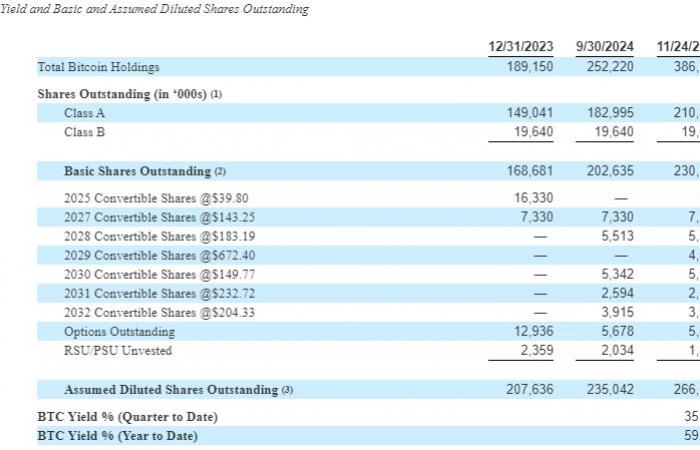8 a.m. ▪
4
min reading ▪ by
Micaiah A.
Not a week goes by without MicroStrategy talking about its crazy purchases in Bitcoin. As the flagship crypto reaches new heights, some wonder why Michael Saylor and his team are not selling to reap profits. However, their strategy seems clear: accumulate at all costs, no matter the price. Today, with a record acquisition of 55,000 BTC, MicroStrategy marks another big blow.
MicroStrategy: 386,700 bitcoins and limitless ambition
MicroStrategy, already famous for its insatiable appetite for bitcoin which will allow it to be valued in the trillions one day, added 55,000 BTC to his wallet between November 18 and 24, spending a trifle of $5.4 billion.
Each BTC cost them environ 97 862 dollarsan astronomical sum which testifies tooverflowing optimism facing the future of the flagship crypto.
With this acquisition, the company holds now 386,700 BTCpurchased in total for $21.9 billioneither an average price of $56,761 per unit. But how to finance such purchases? Thanks to impressive financial engineering:
- Raising 2.97 billion via convertible bonds at 0% interest;
- 2.46 billion generated by a share sales program;
- Remaining capacity of 12.8 billion for future purchases.
Michael Saylor welcomes this “ Bitcoin yield » (BTC Yield) by 59.3% in 2024. The businessman sees in each BTC acquired a colossal growth levermaking his company a unique model in the history of finance.
Crypto investors face a confusing model
This bold strategy fascinates and intrigues crypto investors as much as it does. By making a purchase of bitcoin at such a high price, MicroStrategy is sending a strong signal : bitcoin remains an asset of choice, even near its historic highs. Moreover, the company does not hide its objectives: it wants maximize shareholder value by transforming BTC into the central pillar of its financial strategy.


MicroStrategy’s success is already inspiring other companies. Semler Scientific, for example, recently purchased 297 BTC for $29.1 million, bringing its total to 1,570 BTC. For these firms, the crypto-flagship becomes a real war chest. However, the bet remains risky: the volatility of the crypto market could transform these assets into a time bomb.
In short, MicroStrategy is building an empire on bitcoin, with a bold plan that could revolutionize finance. If some dream of a valuation of 3,000 billion dollars, the path remains strewn with pitfalls. One thing is certain: Michael Saylor’s audacity does not go unnoticed.
Maximize your Cointribune experience with our ‘Read to Earn’ program! For every article you read, earn points and access exclusive rewards. Sign up now and start earning benefits.
Micaiah A.
The blockchain and crypto revolution is underway! And the day when the impacts will be felt on the most vulnerable economy in this world, against all hope, I will say that I had something to do with it








